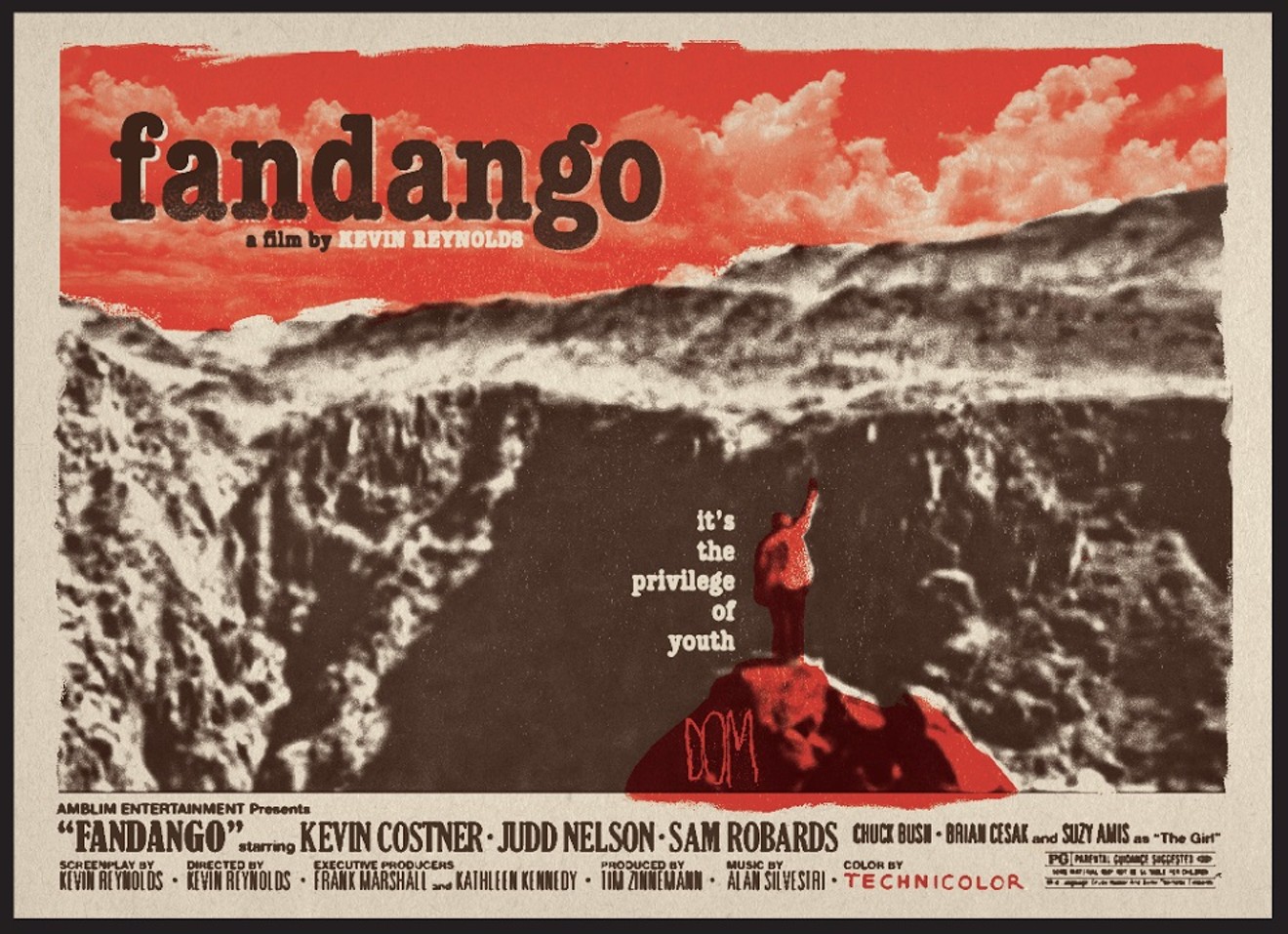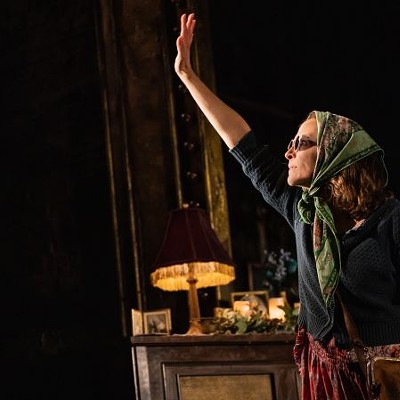When Fandango arrived in theaters in 1985, it made less of a splash than a half-empty bottle of champagne hurled into the Rio Grande (spoiler). Even so, it was hailed as a "notable debut" for director Kevin Reynolds, and no less an authority than Quentin Tarantino called it "one of the best directorial debuts" in movie history. Reynolds displayed a sure hand and a canny eye for what to many were considered the alien landscapes of West Texas.
At the time, he probably had no idea it would be the best movie he ever made.
For the film’s star, on the other hand, the best was yet to come. Coasting on his natural charm and physicality as Gardner Barnes, Kevin Costner would go on to Oscar glory directing Dances With Wolves, in between two near-disastrous pairings with Reynolds: Robin Hood: Prince of Thieves and Waterworld. At least Costner enjoyed a fair amount of success after his arguable directorial high point ("arguable" because Open Range is better).
Fandango tells the story of five 1971 grads from the University of Texas, who — rather than confront the realities of matrimony and the Vietnam War — embark upon a last bravura road trip to dig up their old friend "Dom," laid to rest several years prior on the Texas-Mexico border.
These self-styled "Groovers," consist of Gardner (Costner), the group's lead instigator; Ken Waggener (Sam Robards), Barnes' best friend and the one fleeing marriage; ROTC dweeb Phil Hicks (Judd Nelson, literal moments before Breakfast Club stardom would find him later that year); hulking seminary student Dorman (Chuck Bush); and catatonic future accountant Lester (Brian Cesak). Lester remains passed out for almost the film's entire running time, a harsh commentary on latter-day attitudes toward alcohol poisoning.
The careers of the three leads are fairly well charted (Robards less so, though he's had a steady TV presence in recent decades), but it might interest you to know that Cesak is now a chiropractor right here in Houston. Meanwhile, Bush's story is the stuff of Hollywood legend, though instead of discovering him at a soda fountain, Reynolds spotted him at an Austin 7-11. Bush now runs a VFX company.
Fandango maintains the Groovers’ newfound sense of dissatisfaction and uncertainty throughout their various encounters. Ben, grappling with looming Selective Service just like Gardner, is also experiencing regrets about calling off his wedding to Debbie. Gardner, ever the enabler, insists he made the right choice, even while not-so-subtle flashbacks and dream sequences demonstrate his own fixation on The Girl (Suzy Amis) he left behind.
Everybody has a friend like Gardner Barnes. Need a party organized, or someone to fake a job reference, or lie to a woman about your character at the bar? Gardner's your guy. Friends like him are loyal to a fault, but not the pinnacle of strategic thinking (and also prone to putting the moves on your fiancee). It’s thanks to his poor map reading skills that the group run out of gas, and I just need to point out that the Texas state punishment for being unable to tell a paved from an unpaved road on a map should be eating chili with beans for ten years.
Ominously stranded without food or water near a historical marker for an Indian massacre (the McLean Massacre, which actually occurred in Palestine), the Groovers are forced into a desperate act: train skiing.
The train scene shows why those accolades for Reynolds made sense: from the suspense of the oncoming train, through the tension as Dorman lassoes the last car (contrasted with his utter indifference at the impending catastrophe), and finally, Gardner’s maddeningly nonchalant, “How’re we gonna stop?” The anticlimax of the front end off Phil's car getting yanked off may be the best part of the sequence.
As with all great road movies, Fandango presents a highway excursion much more eventful than the norm. Besides the ultimate train dodge (as Teddy DuChamp might have put it), there's a Roman candle fight with some high schoolers. This happens in a Marfa cemetery and takes on a more sinister tone for impending draftees Gardner and Ken when they encounter the grave of a Vietnam soldier. Here, Reynolds alters the scene from innocent game to a vision of a nightmare battlefield. It's fairly obvious, but still adds weight to the film, and also leads the two men to consider heading across the border to dodge the draft.
But Fandango's most recognizable scene is the sky-diving sequence, itself based on Proof, the USC student film that got Reynolds the attention of Steven Spielberg (his production company Amblin financed Fandango). After an argument where Gardner and Ken rather cruelly inform Phil they only hung out with him because they felt sorry for him, Phil gets a chance to prove his non-weenieness by jumping out of a plane flown by ex-hippie Truman Sparks (Marvin J. McIntyre), which he does ... after Ken promises he won't dodge the draft. The subsequent near-death experience is all Phil needs to become a freer spirit.
Which is nice. I'd hate to think Phil got Neidermeyered in Vietnam.
The rest of the movie follows the expected beats: they dig up Dom (Perignon...surprise!), Gardner realizes Ken's anguish is real, and so the wedding's back on. Problem is, Debbie's in Dallas (just stop), so Gardner convinces their new buddy Truman to pick her up and whisk her down to the border while they con the good people of San Elizario into outfitting the ceremony. Debbie steps off the plane and we see it's the same girl Gardner's been poignantly dreaming about all this time (surprise again!).
And the ease at which a guy in a soiled tuxedo smooth talks the people in this film says a lot about the citizenry of our great state, none of it good.
It’s obviously not a war movie, but Fandango is notable not just for being one of the few movies in which Costner has all his hair, but for being a rare Reagan-era film sympathetically portraying a draft dodger. Released in January, 1985, Fandango arrived at the twilight of the morally ambivalent era of The Deer Hunter and Apocalypse Now, before ushering in the era of “we would’ve won if they’d just taken the gloves off” so well-represented by Missing in Action and Rambo.
More to the point, Fandango is coming-of-age story in the truest sense of the world. In reality, such life-changing transitions are rarely clear-cut, which is why it’s nice to watch Gardner dance one last fandango with Debbie, then toast his departing friends from a distant hilltop. That final image, of Costner in silhouette while holding a beer aloft, is perhaps more resonant now than it was 33 years ago. Inexplicably, the movie only has a 50 percent “Fresh” rating on Rotten Tomatoes, though no contemporaneous reviews are included, so who knows. Come to think of it, maybe I should’ve written about Waterworld instead.
Support Us
Houston's independent source of
local news and culture
account
- Welcome,
Insider - Login
- My Account
- My Newsletters
- Contribute
- Contact Us
- Sign out
Do-Over Cinema: Fandango Celebrates A Series Of Foolish Acts
Pete Vonder Haar September 21, 2018 5:00AM
[
{
"name": "Related Stories / Support Us Combo",
"component": "11591218",
"insertPoint": "4",
"requiredCountToDisplay": "4"
},{
"name": "Air - Billboard - Inline Content",
"component": "11591214",
"insertPoint": "2/3",
"requiredCountToDisplay": "7"
},{
"name": "R1 - Beta - Mobile Only",
"component": "12287027",
"insertPoint": "8",
"requiredCountToDisplay": "8"
},{
"name": "Air - MediumRectangle - Inline Content - Mobile Display Size 2",
"component": "11591215",
"insertPoint": "12",
"requiredCountToDisplay": "12"
},{
"name": "Air - MediumRectangle - Inline Content - Mobile Display Size 2",
"component": "11591215",
"insertPoint": "4th",
"startingPoint": "16",
"requiredCountToDisplay": "12"
}
,{
"name": "RevContent - In Article",
"component": "12527128",
"insertPoint": "3/5",
"requiredCountToDisplay": "5"
}
]
KEEP THE HOUSTON PRESS FREE...
Since we started the Houston Press, it has been defined as the free, independent voice of Houston, and we'd like to keep it that way. With local media under siege, it's more important than ever for us to rally support behind funding our local journalism. You can help by participating in our "I Support" program, allowing us to keep offering readers access to our incisive coverage of local news, food and culture with no paywalls.
Peter Vonder Haar writes movie reviews for the Houston Press and the occasional book. The first three novels in the "Clarke & Clarke Mysteries" - Lucky Town, Point Blank, and Empty Sky - are out now.
Contact:
Pete Vonder Haar
Follow:
Twitter:
@PeterVonderHaar
Trending Arts & Culture
- The Story Stalls But The Beat Goes On in The Cher Show at TUTS
- Top 5 Sickest Stephen King Sex Scenes (NSFW)
- Desperate Lives Buoyed By Dylan's Songs in Girl From the North Country
-
Sponsored Content From: [%sponsoredBy%]
[%title%]

Don't Miss Out
SIGN UP for the latest
arts & culture
news, free stuff and more!
Become a member to support the independent voice of Houston
and help keep the future of the Houston Press FREE
Use of this website constitutes acceptance of our
terms of use,
our cookies policy, and our
privacy policy
The Houston Press may earn a portion of sales from products & services purchased through links on our site from our
affiliate partners.
©2024
Houston Press, LP. All rights reserved.






